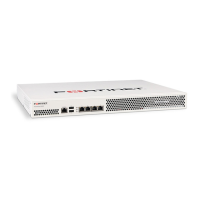Fortinet Technologies Inc. Page 99 FortiVoice 200D/200D-T v2.0 MR1 CLI Reference
system port-forwarding
FortiVoice port forwarding allows remote computers, for example, computers on the Internet, to
connect to a specific computer or service within a private local area network (LAN).
For example, FortiVoice port1 is connected to the Internet and its IP address 192.168.37.4, port
7000, is mapped to 10.10.10.42, port 8000, on a private network. Attempts to communicate
with 192.168.37.4, port 7000, from the Internet are translated and sent to 10.10.10.42, port
8000, by the FortiVoice unit. The computers on the Internet are unaware of this translation and
see a single computer at 192.168.37.4, port 7000, rather than the 10.10.10.42 network behind
the FortiVoice unit.
Before you do the mapping, make sure both ports are open.
Syntax
config system port-forwarding
edit <number>
set dst-host <calss_ip>
set dst-port <port_number>
set host <class_ip>
set port <port_number>
set protocol {tcp | udp | both}
end
Variable Description Default
<number> Enter the index number of the entry.
dst-host <calss_ip> Enter the IP address of the host where the packets will
be forwarded.
0.0.0.0
dst-port <port_number> Enter the port number of the destination host. 0
host <class_ip> Enter the IP address of the FortiVoice interface where the
packets are received.
0.0.0.0
port <port_number> Enter the port number on the FortiVoice interface where
the packets are received.
0
protocol {tcp | udp |
both}
Specify the protocol of the traffic. tcp

